 W
WThe Admonitions Scroll is a Chinese narrative painting on silk that is traditionally ascribed to Gu Kaizhi, but which modern scholarship regards as a 5th to 8th century work that may or may not be a copy of an original Jin Dynasty (265–420) court painting by Gu. The full title of the painting is Admonitions of the Court Instructress. It was painted to illustrate a poetic text written in 292 by the poet-official Zhang Hua (232–300). The text itself was composed to reprimand Empress Jia (257–300) and to provide advice to the women in the imperial court. The painting illustrates this text with scenes depicting anecdotes about exemplary behaviour of historical palace ladies, as well as with more general scenes showing aspects of life as a palace lady.
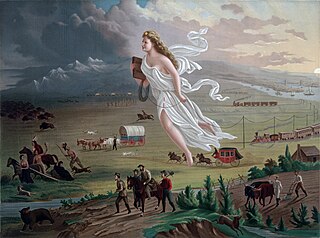 W
WAmerican Progress is an 1872 painting by John Gast, a Prussian-born painter, printer, and lithographer who lived and worked most of his life in Brooklyn, New York. American Progress, an allegory of Manifest Destiny, was widely disseminated in chromolithographic prints. It is now held by the Autry Museum of the American West in Los Angeles, California.
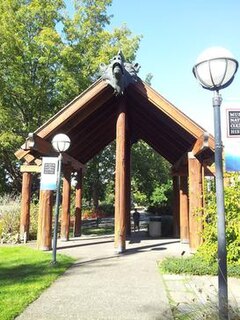 W
WBear Gargoyle is an outdoor 1988 sculpture by Wayne Chabre, installed at the University of Oregon Museum of Natural and Cultural History in Eugene, Oregon, United States. It depicts the head of a grizzly bear with a Kwakwaka'wakw bear mask on top. The sculpture is made of hammered 32 oz. copper over a stainless steel frame and measures approximately 5.5 feet (1.7 m) x 4 feet (1.2 m) x 5 feet (1.5 m). Its condition was deemed "treatment needed" by the Smithsonian Institution's "Save Outdoor Sculpture!" program in March 1993. The sculpture is administered by the University of Oregon.
 W
WThe bear as heraldic charge is not as widely used as the lion, boar or other beasts.
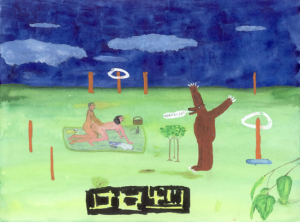 W
WBear Surprise is a watercolor painting by American painter/musician John Lurie, the style of which has been described as primitivist and naïve. The painting depicts a couple having sex in a meadow, with a bear standing in front of them, with fore paws in a distinctive position. There is a speech bubble beside the head of the bear, which reads "Surprise!".
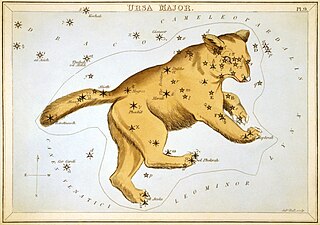 W
WBears in antiquity had natural observations recorded about them from as the early as Classical Greece, and were part of most natural histories that followed. One knows from Pausanias that bears roamed ancient Greece, and archaeological evidence found such as bear teeth attest to his witness. Natural Histories that studied bears were recorded by Aristotle, Aelian, Pliny and Oppian and were probably based on their first hand accounts or the testimony of hunters. Bears came to represent a state between wild and tame, and were represented as such in cultural appropriations. The image of the bear was also commercialised in trade, as were its body parts.
 W
WThe California Diamond Jubilee half dollar was a United States commemorative silver fifty-cent piece struck at the San Francisco Mint in 1925. It was issued to celebrate the 75th anniversary of California statehood.
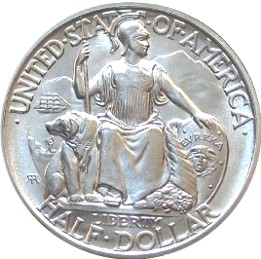 W
WThe California Pacific International Exposition half dollar, sometimes called the California Pacific half dollar or the San Diego half dollar, is a commemorative fifty-cent piece struck by the United States Bureau of the Mint in 1935 and 1936. Robert I. Aitken designed the coin. Its obverse depicts Minerva and other elements of the Seal of California; the reverse shows buildings from the California Pacific International Exposition, which the coin was issued to honor.
 W
WThe toonie, formally the Canadian two-dollar coin, was introduced on February 19, 1996, by Minister of Public Works Diane Marleau. As of 2019, it possesses the highest monetary value of any circulating Canadian coin. The toonie is a bi-metallic coin which on the reverse side bears an image of a polar bear by artist Brent Townsend. The obverse, like all other current Canadian circulation coins, has a portrait of Queen Elizabeth II. It has the words ELIZABETH II / D.G. REGINA in a different typeface from any other Canadian coin.
 W
WBears have been popular subjects in art, literature, folklore and mythology. Public perception of bears is often positive, as people identify with bears due to their omnivorous diets, their ability to stand on two legs, and their symbolic importance.
 W
WEakins Oval is a traffic circle in Philadelphia. It forms the northwest end of the Benjamin Franklin Parkway just in front of the Philadelphia Museum of Art, with a central array of fountains and monuments, and a network of pedestrian walkways.
 W
WThe flag of Berlin has three stripes of red-white-red, the two outer stripes each occupying a fifth of its height, the middle the remaining three fifths. It is emblazoned with a bear on the civil flag, while it bears the coat of arms of Berlin on the state flag.
 W
WThe Bear Flag is the official flag of the U.S. state of California. The precursor of the flag was first flown during the 1846 Bear Flag Revolt and was also known as the Bear Flag.
 W
WFur Traders Descending the Missouri is an 1845 painting by George Caleb Bingham. Bingham brought the painting to St. Louis, Missouri on June 4, 1845, along with several other pieces of artwork.
 W
WThe Horace Rackham Memorial Fountain (1939), also known as the Bear Fountain, is a fountain located in the Detroit Zoo, Royal Oak, Michigan. It was designed by Frederick A. Schnaple (1872–1948) and sculpted by Corrado Parducci.
 W
WI See What You Mean, also known as the "Big Blue Bear", is a 40-foot-tall sculpture of a blue bear by Lawrence Argent, installed outside the Colorado Convention Center, in Denver. The piece was installed at a cost of US$424,400, and was immediately popular with both the public and art community.
 W
WMan Proposes, God Disposes is an 1864 oil-on-canvas painting by Edwin Landseer. The work was inspired by the search for Franklin's lost expedition which disappeared in the Arctic after 1845. The painting is in the collection of Royal Holloway, University of London, and is the subject of superstitious urban myth that the painting is haunted.
 W
WThe Morning in a Pine Forest is a painting by Russian artists Ivan Shishkin and Konstantin Savitsky. The bears were painted by Savitsky, but the art collector Pavel Tretyakov effaced his signature, stating that "from idea until performance, everything discloses the painting manner and creative method peculiar just to Shishkin", so the painting is now credited solely to Shishkin.
 W
WThe San Francisco–Oakland Bay Bridge half dollar or Bay Bridge half dollar is a commemorative fifty-cent piece struck by the United States Bureau of the Mint in 1936. One of many commemoratives issued that year, it was designed by Jacques Schnier and honors the opening of the Bay Bridge that November. One side of the coin depicts a grizzly bear, a symbol of California, and the other shows the San Francisco–Oakland Bay Bridge, with the Ferry Building in the foreground.
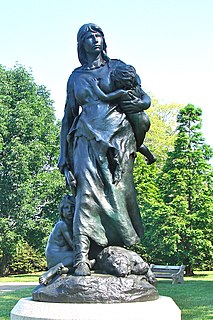 W
WStone Age in America is an 1887 bronze statue by John J. Boyle located in Philadelphia, in Fairmount Park on Kelly Drive near Boathouse Row.
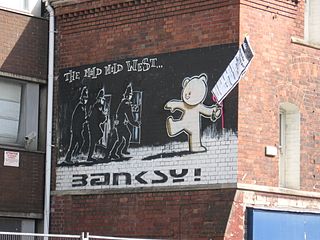 W
WThe Mild Mild West is a mural by graffiti artist Banksy, sited on No. 80 Stokes Croft, Bristol. It depicts a teddy bear throwing a Molotov cocktail at three riot police.
 W
WBuddy Bears are painted, life-size fiberglass bear sculptures developed by German businesspeople Klaus and Eva Herlitz, in cooperation with sculptor Roman Strobl. They have become a landmark of Berlin and are considered unofficial ambassadors of Germany. The outstretched arms of the standing Buddy Bear symbolise friendliness and optimism. The first bears were displayed at an artistic event in Berlin in 2001.
 W
WUntitled Totem Pole is a 1984 cedar totem pole created by James Bender and Marvin Oliver, installed in Seattle's Victor Steinbrueck Park, in the U.S. state of Washington.